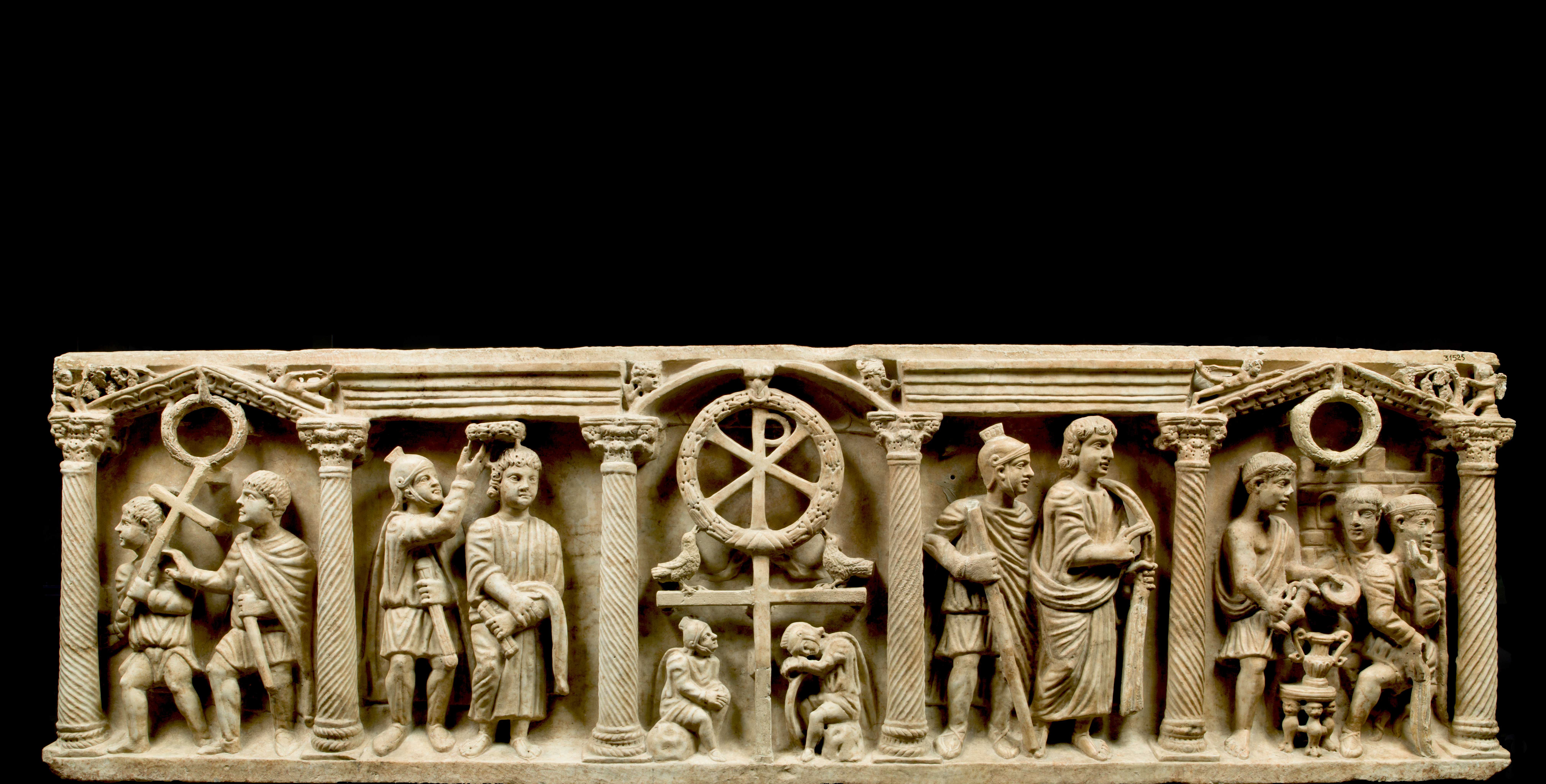Early Christian Sarcophagus with Scenes of the Passion
Artist: Unknown
Date: 350 AD
Classification: Sarcophagus
Dimensions: 59 x 202 x 80 cm
Materials: Marble, Stones, Plaster
Adopted By: The Belgium Chapter
Total Cost: $ 16,000
Description
The sarcophagus presents a series of episodes relating to the Passion of Jesus providing both a narrative sequence and an exegetical commentary on its meaning. Five groups of figures are placed within architectural niches framed by six spirally fluted columns crowned with ornate floral capitals. The two groups on the right side portray Christ’s appearance before Pontius Pilate. A helmeted Roman soldier leads Jesus, who holds a scroll and raises his right hand in a gesture of speech. To the right sits Pontius Pilate wearing a royal diadem as a sign of authority; his body faces Jesus but his head is turned away and his chin rests upon his hand in a gesture of grief. Behind Pilate, another Roman official sits and before him stands an attendant pouring water from a jug into a shallow bowl in which Pilate will wash his hands. On the left side of the sarcophagus, in the second niche, an armed Roman soldier places a jeweled wreath on the head of Christ, who stands passively. To the left, Simon of Cyrene carries Christ’s cross pressed on by a Roman soldier, below another wreath.
The central niche contains a composition that, by the use of allusive symbols, depicts Christ’s triumph over death through his Crucifixion and Resurrection. The cross of the Crucifixion is surmounted by the chi-rho monogram held by an eagle. Above, two small busts personify the sun and moon to denote the cosmic significance of Christ’s triumph. Two doves, popular Christian symbols of Resurrection, stand on the cross. The two roman soldiers who guarded the Holy Sepulcher and bore witness to Christ’s resurrection sit at its foot. All the episodes related to the central theme of Christ’s victory allude to the significance of the Passion showing how Christ’s sacrifice and triumph are paralleled by those of earlier old Testament heroes and Christ’s apostolic successors.
Detail
Adopted By:
The Belgium ChapterInventory N°: 31525
Artist: Unknown
Date: 350 AD
Dimensions: 59 x 202 x 80 cm
Materials: Marble, Stones, Plaster
Department:
Christian AntiquitiesCurators:
Dr. Umberto Utromuseum:
Pius-Christian MuseumLaboratories:
Stone MaterialsWishbook year: 2014
Total Cost
$ 16,000

Early Christian Sarcophagus with Scenes of the Passion

Details
Adopted by: The Belgium Chapter
Inventory: 31525
Artist: Unknown
Date: 350 AD
Classification: Sarcophagus
Materials: Marble, Stones, Plaster
Dimensions: 59 x 202 x 80 cm
Museum: Pius-Christian Museum
Department: Christian Antiquities
Laboratory: Stone Materials
Wishbook year: 2014
Description
The sarcophagus presents a series of episodes relating to the Passion of Jesus providing both a narrative sequence and an exegetical commentary on its meaning. Five groups of figures are placed within architectural niches framed by six spirally fluted columns crowned with ornate floral capitals. The two groups on the right side portray Christ’s appearance before Pontius Pilate. A helmeted Roman soldier leads Jesus, who holds a scroll and raises his right hand in a gesture of speech. To the right sits Pontius Pilate wearing a royal diadem as a sign of authority; his body faces Jesus but his head is turned away and his chin rests upon his hand in a gesture of grief. Behind Pilate, another Roman official sits and before him stands an attendant pouring water from a jug into a shallow bowl in which Pilate will wash his hands. On the left side of the sarcophagus, in the second niche, an armed Roman soldier places a jeweled wreath on the head of Christ, who stands passively. To the left, Simon of Cyrene carries Christ’s cross pressed on by a Roman soldier, below another wreath.
The central niche contains a composition that, by the use of allusive symbols, depicts Christ’s triumph over death through his Crucifixion and Resurrection. The cross of the Crucifixion is surmounted by the chi-rho monogram held by an eagle. Above, two small busts personify the sun and moon to denote the cosmic significance of Christ’s triumph. Two doves, popular Christian symbols of Resurrection, stand on the cross. The two roman soldiers who guarded the Holy Sepulcher and bore witness to Christ’s resurrection sit at its foot. All the episodes related to the central theme of Christ’s victory allude to the significance of the Passion showing how Christ’s sacrifice and triumph are paralleled by those of earlier old Testament heroes and Christ’s apostolic successors.
Media

Sarcophagus with Scenes of the Passion - Before Restoration

Sarcophagus with Scenes of the Passion - During Restoration

Sarcophagus with Scenes of the Passion - After Restoration

© 2025 Patrons of the Arts
in the Vatican Museums
Vatican Museums V-00120,
Vatican City State (Europe)
+39 0669864499
